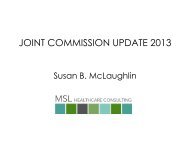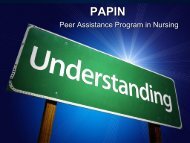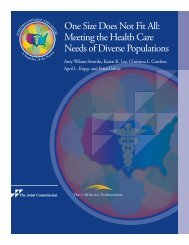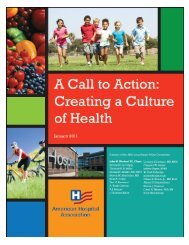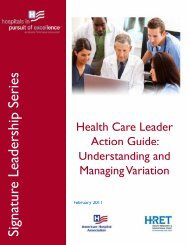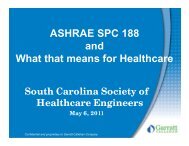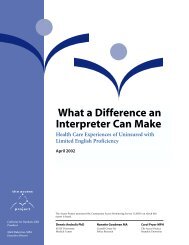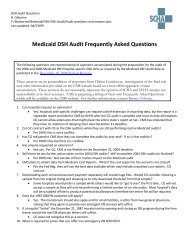Case Study: Hospital â FQHC Affiliation
Case Study: Hospital â FQHC Affiliation
Case Study: Hospital â FQHC Affiliation
Create successful ePaper yourself
Turn your PDF publications into a flip-book with our unique Google optimized e-Paper software.
Anna Carvalho, FACHE<br />
Vice President, Strategic Planning And Business<br />
Development<br />
Holy Cross <strong>Hospital</strong>, Chicago, IL
Holy Cross <strong>Hospital</strong><br />
• Safety net (DSH)<br />
• Inpatient ADC: 117<br />
• CMI: Medicare 1.3 / Overall 1.15<br />
• Ambulance arrivals: 16,000 per year<br />
• Payor mix (patient days):<br />
• Medicare 53%<br />
• Medicaid 31%<br />
• HMO/PPO 11%<br />
• Self-pay/Other 4.5% (36% increase from prior year)
Community<br />
• Health indicators poor<br />
• Income and education:<br />
70% make $50,000 or less<br />
70% have a high school degree or less<br />
• Mostly African American and Latino<br />
• Churning: 20% of community turns over annually
<strong>Hospital</strong> Status by Fall 2008<br />
• 3.5 days cash<br />
• 15 % staff cut<br />
• Suspension of labor and<br />
delivery
Strategic Value of <strong>FQHC</strong> affiliates<br />
• Skeleton of new primary care system for under-insured<br />
area<br />
• Ability to attract well-qualified staff<br />
• FTCA coverage, lifestyle, no office headaches<br />
• Focus on women and children – assist with reopening<br />
of Labor and Delivery
Features of agreement<br />
• <strong>Affiliation</strong> plus subcontracts<br />
• Catholic Ethical and Religious Directives<br />
• Joint ED Diversion grant to get site opened<br />
• Innovative OB <strong>Hospital</strong>ist arrangement<br />
• Labs and ancillaries provided by hospital<br />
• Staffed with OB and family practitioner<br />
Also:<br />
• <strong>Hospital</strong> insisted on “open” campus: recruited second<br />
<strong>FQHC</strong> to nearby site; works with other <strong>FQHC</strong>S
Benefits of agreement<br />
• <strong>FQHC</strong> focused on primary care while hospital focused on core<br />
business<br />
• <strong>FQHC</strong> able to attract OBs (FTCA) & front the cost of OB<br />
hospitalist program<br />
• Source of primary care for the under-/uninsured<br />
• Potential for OB referrals from multiple <strong>FQHC</strong> sites
Challenges of agreement<br />
• Performance issues – different priorities, risks,<br />
unexpected hurdles<br />
• Reduced opportunity for private practitioners (OB call)<br />
• <strong>FQHC</strong> co-pays still make the (“free”) ED an attractive<br />
alternative to our customers<br />
• Increased complexity of managing referrals
Future directions<br />
• Continued growth of <strong>FQHC</strong>s, increased efforts to refer patients<br />
to medical homes<br />
• Make referral environment more attractive to multiple providers<br />
(access to OB call)<br />
• Increase patient engagement<br />
• Joint efforts to improve population health



